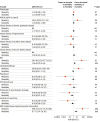Timing of Cholecystectomy After Moderate and Severe Acute Biliary Pancreatitis
- PMID: 37610760
- PMCID: PMC10448376
- DOI: 10.1001/jamasurg.2023.3660
Timing of Cholecystectomy After Moderate and Severe Acute Biliary Pancreatitis
Erratum in
-
Errors in Results and Table 2.JAMA Surg. 2024 Mar 1;159(3):353. doi: 10.1001/jamasurg.2023.7086. JAMA Surg. 2024. PMID: 38198149 Free PMC article. No abstract available.
Abstract
Importance: Considering the lack of equipoise regarding the timing of cholecystectomy in patients with moderately severe and severe acute biliary pancreatitis (ABP), it is critical to assess this issue.
Objective: To assess the outcomes of early cholecystectomy (EC) in patients with moderately severe and severe ABP.
Design, settings, and participants: This cohort study retrospectively analyzed real-life data from the MANCTRA-1 (Compliance With Evidence-Based Clinical Guidelines in the Management of Acute Biliary Pancreatitis) data set, assessing 5304 consecutive patients hospitalized between January 1, 2019, and December 31, 2020, for ABP from 42 countries. A total of 3696 patients who were hospitalized for ABP and underwent cholecystectomy were included in the analysis; of these, 1202 underwent EC, defined as a cholecystectomy performed within 14 days of admission. Univariable and multivariable logistic regression models were used to identify prognostic factors of mortality and morbidity. Data analysis was performed from January to February 2023.
Main outcomes: Mortality and morbidity after EC.
Results: Of the 3696 patients (mean [SD] age, 58.5 [17.8] years; 1907 [51.5%] female) included in the analysis, 1202 (32.5%) underwent EC and 2494 (67.5%) underwent delayed cholecystectomy (DC). Overall, EC presented an increased risk of postoperative mortality (1.4% vs 0.1%, P < .001) and morbidity (7.7% vs 3.7%, P < .001) compared with DC. On the multivariable analysis, moderately severe and severe ABP were associated with increased mortality (odds ratio [OR], 361.46; 95% CI, 2.28-57 212.31; P = .02) and morbidity (OR, 2.64; 95% CI, 1.35-5.19; P = .005). In patients with moderately severe and severe ABP (n = 108), EC was associated with an increased risk of mortality (16 [15.6%] vs 0 [0%], P < .001), morbidity (30 [30.3%] vs 57 [5.5%], P < .001), bile leakage (2 [2.4%] vs 4 [0.4%], P = .02), and infections (12 [14.6%] vs 4 [0.4%], P < .001) compared with patients with mild ABP who underwent EC. In patients with moderately severe and severe ABP (n = 108), EC was associated with higher mortality (16 [15.6%] vs 2 [1.2%], P < .001), morbidity (30 [30.3%] vs 17 [10.3%], P < .001), and infections (12 [14.6%] vs 2 [1.3%], P < .001) compared with patients with moderately severe and severe ABP who underwent DC. On the multivariable analysis, the patient's age (OR, 1.12; 95% CI, 1.02-1.36; P = .03) and American Society of Anesthesiologists score (OR, 5.91; 95% CI, 1.06-32.78; P = .04) were associated with mortality; severe complications of ABP were associated with increased mortality (OR, 50.04; 95% CI, 2.37-1058.01; P = .01) and morbidity (OR, 33.64; 95% CI, 3.19-354.73; P = .003).
Conclusions and relevance: This cohort study's findings suggest that EC should be considered carefully in patients with moderately severe and severe ABP, as it was associated with increased postoperative mortality and morbidity. However, older and more fragile patients manifesting severe complications related to ABP should most likely not be considered for EC.
Conflict of interest statement
Figures



Comment in
-
Early cholecystectomy cannot be regarded as a mortality risk factor in moderate and severe acute biliary pancreatitis.Hepatobiliary Surg Nutr. 2024 Feb 1;13(1):109-111. doi: 10.21037/hbsn-23-593. Epub 2024 Jan 15. Hepatobiliary Surg Nutr. 2024. PMID: 38322210 Free PMC article. No abstract available.
Comment on
-
Prevention of Recurrences in Acute Biliary Pancreatitis.JAMA Surg. 2023 Oct 1;158(10):e233670. doi: 10.1001/jamasurg.2023.3670. Epub 2023 Oct 11. JAMA Surg. 2023. PMID: 37610738 No abstract available.
References
Publication types
MeSH terms
Grants and funding
LinkOut - more resources
Full Text Sources
Medical

